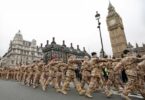Iqbal Khan
Afghans had enjoyed a period of relative calm in run up to the February 29 accord, but the conflict resurfaced soon after the deal was signed. According to Aljazeera Taliban have since rejected multiple calls for a ceasefire during the Islamic holy month of Ramadan. President Ashraf Ghani had also appealed to the group to lay down arms for the holy month. The United Nations Assistance Mission in Afghanistan (UNAMA) Chief Deborah Lyons said, “To safeguard the lives of countless civilians in Afghanistan and to give the nation hope of a better future, it is imperative that violence is stopped with the establishment of a ceasefire and for peace negotiations to commence.
UNAMA reported on April 27 that violence surged in Afghanistan in the weeks after the United States and the Taliban signed a deal 0n February 29. The release of the UNAMA report comes hours after the US special envoy Zalmay Khalilzad called upon Taliban to implement a humanitarian ceasefire while Afghanistan tries to tackle its worsening coronavirus crisis. Taliban have launched their own campaign to help Afghanistan fight coronavirus. Afghanistan has detected more than 1,300 cases of the virus, but health experts say the number could be higher as testing is limited and Afghanistan’s weak healthcare system would have to struggle with a widespread outbreak.
Paradoxically, UNAMA has noted that pro-government forces were responsible for more than twice as many child deaths than Taliban during the first quarter, mainly due to air strikes and shelling. “The report tracks a disturbing increase in violence during March at a time when it was hoped that the Government of Afghanistan and the Taliban would commence peace negotiations,” UNAMA said in a statement accompanying the release of its quarterly report.
More than 500 civilians were killed and over 700 injured during the first three months of the year, UNAMA report said. While casualty numbers rose in March, UNAMA noted that the overall toll for the first quarter of 2020 was down 29 per cent from a year earlier, thanks to a lull in fighting in January and February. However, fighting spiked in March as the Afghan government and Taliban bickered over a number of issues, preventing negotiations between the two from opening. Recent attacks have mostly been limited to rural areas and small towns. Under the framework of US-Taliban deal, the insurgents have agreed not to attack cities. Taliban have rejected the figures, claiming the report “conceals the daily crimes” committed by the government and US forces.
Taliban have cited continuing disagreements over peace process and a delayed prisoner swap as reasons to keep fighting. Out of promised 5000, Afghan government released only 100 Taliban prisoners Taliban spokesman Suhail Shaheen said a ceasefire would be possible if a potential peace process was being implemented “fully”, but “hurdles” meant the Taliban would not yet lay down arms. “Asking for ceasefire is not rational and convincing,” wrote Shaheen. Citing disagreements over the peace process and a delay-ed prisoner exchange as re-asons to keep fighting, the Taliban spokesman accus-ed the Afghan government of putting prisoners’ lives at risk during the outbreak.
Under the deal, the Afghan government and the fighters were by now supposed to have concluded the prisoner swap and started talks aimed at bringing about a comprehensive ceasefire. The latest round of disputes came after dozens of Afghan security forces personnel were killed in a fresh wave of violence launched by the Taliban this week.
American and other occupation forces have pledged to leave Afghanistan by July 2021, provided the Taliban sticks to several security guarantees and holds talks with the government. “The current level of violence caused by the Taliban is not acceptable,” alliance ambassadors in NATO’s North Atlantic Council said in a statement on the peace efforts. Ghani had been calling for a lasting ceasefire with the Taliban for years, only to be ignored by the increasingly emboldened fighters. The Taliban instead has mocked Ghani’s government, referring to them as “puppets” controlled by foreign powers, and have roundly refused to engage in peace talks as it intensifies attacks on Afghan forces. The peace deal did not include a ceasefire, which has been left to the US backed government to negotiate with the insurgents.
Why Are the Taliban Reluctant to Declare a Ceasefire? It’s not only a negotiating tactic. There’s real fear on the Taliban’s end about what happens after the guns go silent. The cessation of hostilities, however, seems to be a tricky subject with the Taliban leadership. Judging by their own statements and those of US peace envoy Zalmay Khalilzad, one may assume that a complete ceasefire with the Afghan government, if it comes at all, lies at the far end of the road leading to the final peace agreement.
According to Daud Khattak Taliban’s reluctance to declare a ceasefire is understandable for several reasons. The overriding reason in that many Taliban militants did not return to join the fighting after the first ceasefire with the Afghan government over a year ago. That was the first time since the overthrow of Taliban regime that the militants freely mixed with their compatriots. They received hugs, posed for selfies, and some were even presented with flowers by common citizens in the streets of Kabul and other major cities.
But a different look may also reveal the fear factor that keeps the militia’s leadership from disengaging their fighters. More efforts with trust building may help achieve lasting peace in the post-withdrawal Afghanistan. Fearing a repetition of the same experience, Taliban are not likely to come to a complete ceasefire until they get what they want from an expected peace deal.






